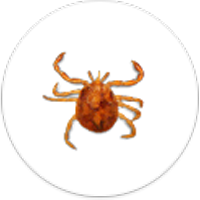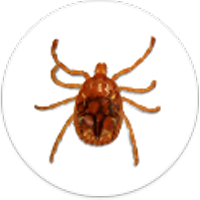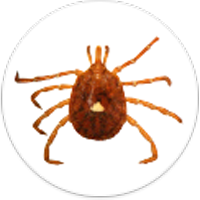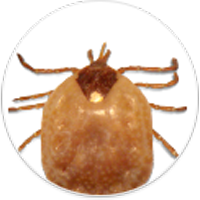Lone Star tick
Amblyomma americanum
Identification
Female lone star ticks are brown and have a single sliver-white spot on their dorsal (back) side, thus the name “lone star” tick. They’re about 3/16 of an inch long and can increase to about 7/16 of an inch long when fully fed. Males are brown with white markings on their back plate.4

Nymph

Male

Female

Engorged Female
Approximate Distribution

Lone star ticks can be found in the south, central and eastern United States from central Texas and Oklahoma eastward across the southern states. They’re present along the Atlantic coast as far north as Maine.5
Hosts

This tick can be found on humans, cattle, dogs, horses, goats, ground-dwelling birds like quail and wild turkeys. It can also be found on small wild mammals like squirrels, opossums and hares as well as larger wild mammals like white-tailed deer and coyotes.6
Habitat

Lone star ticks are commonly found in grassy and shrubby areas and in shady locations along roadsides and meadows.4
Diseases associated with Dermacentor variabilis20, 21
Cytauxzoonosis
Cytauxzoonosis is a severe and life-threatening disease in cats caused by the parasite Cytauxzoon felis. The disease is dangerous and requires prompt action for chances of recovery. Signs of infection usually begin about 10 days after a tick bite and peak about six days later.
Clinical Signs
In cats: 31, 32
● Depression
● Decreased energy
● Loss of appetite
● Fever
● Dehydration
● Jaundice
Cytauxzoonosis does not affect dogs.
Diagnosis and testing
Veterinary professionals diagnose cytauxzoonosis in cats using blood tests and/or fine-needle aspiration of lymph nodes, spleen, or liver to help identify the presence of the parasite.31, 32
Treatment
The recommended treatment for cytauxzoonosis typically involves the drugs atovaquone and azithromycin. It may also include supportive care such as nutritional support and IV fluids.32
References:
31. Blood Parasites of Cats. Merck Vet Manual. https://www.merckvetmanual.com/cat-owners/blood-disorders-of-cats/blood-parasites-of-cats
32. Cytauxzoonosis in Cats. Merck Vet Manual. https://www.merckvetmanual.com/circulatory-system/blood-parasites/cytauxzoonosis-in-cats
Ehrlichiosis
Ehrlichiosis is a serious disease caused by the Ehrlichia bacteria. It affects both dogs and cats. 33, 34
Clinical Signs
In dogs and cats: 33, 34
● Fever
● Swollen lymph nodes
● Loss of appetite
● Depression
● Muscle stiffness
● Coughing
If the disease progresses, long-term signs include bleeding and bruising caused by low levels of platelets in the blood.
Diagnosis and testing
Diagnosing ehrlichiosis involves a combination of observing clinical signs and conducting blood and laboratory tests, which help confirm the presence of the Ehrlichia organism and assess the severity of the infection.33, 34
Treatment
The primary treatment for ehrlichiosis in both dogs and cats typically involves the use of doxycycline, an antibiotic. It can also include supportive care to address symptoms and keep your pet more comfortable.35
References:
33. Ehrlichiosis and Related Infections in Dogs. Merck Vet Manual. https://www.merckvetmanual.com/dog-owners/disorders-affecting-multiple-body-systems-of-dogs/ehrlichiosis-and-related-infections-in-dogs
34. Ehrlichiosis and Related Infections in Cats. Merck Vet Manual. https://www.merckvetmanual.com/cat-owners/disorders-affecting-multiple-body-systems-of-cats/ehrlichiosis-and-related-infections-in-cats
35. Ehrlichiosis, Anaplasmosis, and Related Infections in Animals. Merck Vet Manual. https://www.merckvetmanual.com/generalized-conditions/rickettsial-diseases/ehrlichiosis,-anaplasmosis,-and-related-infections-in-animals
Rickettsiosis (spotted fever group)
Spotted fever group Rickettsiosisis a group of diseases caused by various species of the Rickettsia bacteria. They can affect both cats and dogs, though cats generally show no symptoms and may have been infected by contact with fleas, not ticks.38, 39
Clinical Signs
In dogs:38
● Fever
● Loss of appetite
● Swollen lymph nodes
● Painful joints
● Coughing
● Vomiting
● Diarrhea
● Swelling of face or extremities
Diagnosis and testing
To diagnose a dog, your veterinarian will likely use a combination of observing the signs and conducting blood and laboratory testing.38
Treatment
Treatment typically involves the use of the antibiotic doxycycline. In addition to medication, your pet may receive supportive care and careful monitoring to help manage symptoms and ensure well-being.38
References:
38. Rocky Mountain Spotted Fever in Dogs. Merck Vet Manual. https://www.merckvetmanual.com/generalized-conditions/rickettsial-diseases/rocky-mountain-spotted-fever-in-dogs
39. Flea-borne Rickettsiosis. Companion Animal Parasite Council. https://capcvet.org/guidelines/flea-borne-rickettsiosis/
Tick paralysis
Tick paralysis is caused by the exposure to neurotoxin released by a tick’s salivary glands when it bites. It’s a severe and potentially fatal condition that requires immediate veterinary attention. Both dogs and cats can be affected. Signs typically appear between three and nine days after the tick attaches, depending on the tick species.43
Clinical Signs
In dogs and cats:43
● Change or loss of voice
● Lack of coordination in hind legs
● Changes in breathing rate and effort
● Gagging
● Coughing
● Vomiting
● Dilated pupils
Diagnosis and testing
Diagnosis is primarily based on the presence of a tick and the observation of clinical signs. Specific laboratory tests are not typically available for tick paralysis.43
Treatment
Treating tick paralysis involves several crucial steps. First and foremost is the removal of the attached tick. Supportive care, such as IV fluids and respiratory support, is also important, as is reducing anxiety and stress in your pet.43
References:
43. Tick Paralysis in Animals. Merck Vet Manual. https://www.merckvetmanual.com/nervous-system/tick-paralysis/tick-paralysis-in-animals
Tularemia
Tularemia, sometimes called rabbit fever, is a disease caused by the bacteria Francisella tularensis. It’s aserious condition that affects both dogs and cats. Even with early diagnosis and treatment, the death rate among cats with tularemia is high. In dogs, early treatment is crucial to prevent death, and in some cases, prolonged treatment may be necessary.44, 45
Clinical Signs
In cats and dogs:44, 45
● Sudden high fever
● Swollen glands
● Decreased energy
● Loss of appetite
Some cats may show no signs of the disease, while others may become very ill.45
Diagnosis and testing
Diagnosis involves blood tests to detect antibodies that indicate the presence of the bacteria.46
Treatment
Treatment typically involves the antibiotics streptomycin, gentamicin, and tetracycline.46 In dogs, early treatment is essential to prevent death, and some dogs may require prolonged treatment, depending on the severity of the infection.44
References:
44. Tularemia (Rabbit Fever) in Dogs. Merck Vet Manual. https://www.merckvetmanual.com/dog-owners/disorders-affecting-multiple-body-systems-of-dogs/tularemia-rabbit-fever-in-dogs
45. Tularemia in Cats. Merck Vet Manual. https://www.merckvetmanual.com/cat-owners/disorders-affecting-multiple-body-systems-of-cats/tularemia-in-cats
46. Tularemia in Animals. Merck Vet Manual. https://www.merckvetmanual.com/generalized-conditions/tularemia/tularemia-in-animals
References:
4. Ticks and Tick-Borne Diseases. Ohio State University Extension. https://ohioline.osu.edu/factsheet/HYG-2073
5. Approximate Distribution of the Lone Star Tick. Centers for Disease Control. https://www.cdc.gov/ticks/maps/lone_star_tick.html
6. Featured Creatures: Lone Star Tick. University of Florida https://entnemdept.ufl.edu/creatures/urban/medical/lone_star_tick.htm
20. Ticks. Companion Animal Parasite Council. https://capcvet.org/guidelines/ticks/
21. Tick Paralysis in Animals. Merck Vet Manual. https://www.merckvetmanual.com/nervous-system/tick-paralysis/tick-paralysis-in-animals

 Austria
Austria Belgium
Belgium Czech Republic
Czech Republic Denmark
Denmark Europe
Europe Finland
Finland France
France Germany
Germany Greece
Greece Hungary
Hungary Ireland
Ireland Israel
Israel Italy
Italy Netherlands
Netherlands Norway
Norway Poland
Poland Portugal
Portugal Romania
Romania Spain
Spain Sweden
Sweden Turkey
Turkey United Kingdom
United Kingdom United States
United States